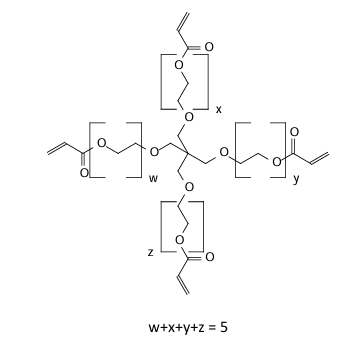Enhanced TDS
Identification & Functionality
- Blend
- No
- CASE Ingredients Functions
- Chemical Family
- Function
- Binder
- Product Code
- MITM12334
- Single Ingredient
- Yes
- Technologies
- Product Families
- Chemical Structure

Features & Benefits
- CASE Ingredients Features
- Performance Highlights
EBECRYL® 50 is characterized by:
- Light color
- Low viscosity
- Low odor
UV/EB cured products based on EBECRYL® 50 are characterized by the following performance properties:
- Good cure response
- High surface hardness
- Good solvent resistance
- Low residual odor
- Low impurity profile
The actual properties of UV/EB cured products also depend on the selection of the other formulation components, such as reactive diluent(s), additives and photoinitiators.
Applications & Uses
- Application Method
- Coating End Applications
- Compatible Substrates & Surfaces
- Cure Method
- Ink & Toner End Applications
- Markets
- Applications
- Product Applications
Formulated UV/EB curable products containing EBECRYL® 50 may be applied by offset, flexo, screen, gravure, direct or reverse roll, and curtain coating methods.
EBECRYL® 50 is recommended for use in:- Offset and flexo inks as a reactive diluting acrylate
- Overprint varnishes
- Coatings on paper, plastics, cardboard
- Paper upgrading
Properties
- Physical Form
Packaging & Availability
- Packaging Type
Principal Information
- Group Principal Number
- S000001
- Principal
Storage & Handling
- Storage Conditions
- Care should be taken not to expose the product to high temperature conditions, direct sunlight, ignition sources, oxidizing agents, alkalis or acids.
- This might cause uncontrollable polymerization of the product with the generation of heat.
- Storage and handling should be in stainless steel, amber glass, amber polyethylene or baked phenolic lined containers.
- Procedures that remove or displace oxygen from the material should be avoided.
- Do not store this material under an oxygen free atmosphere.
- Dry air is recommended to displace material removed from the container.
- Wash thoroughly after handling.
- Keep container tightly closed.
- Use with adequate ventilation.
Other
- Appearance (SDS)
- Clear liquid
- Color (SDS)
- Pale yellow
- IATA/ICAO Proper Shipping Name
- Environmentally hazardous substance, liquid, N.O.S.
- IATA/ICAO Technical name (N.O.S.)
- acrylated esters
- IATA/ICAO UN Number
- UN3082
- IMO/IMDG Proper Shipping Name
- Environmentally hazardous substance, liquid, N.O.S.
- IMO/IMDG Technical name (N.O.S.)
- acrylated esters
- IMO/IMDG UN Number
- UN3082
- Item Number
- Odor (SDS)
- Ester like
- Other Hazards
- Polymerization may occur from excessive heat, contamination or exposure to direct sunlight .
- Protect from Freezing
- Yes
- TDG Canada Proper Shipping Name
- Environmentally hazardous substance, liquid, N.O.S.
- TDG Canada Technical name (N.O.S.)
- acrylated esters
- TDG Canada UN Number
- UN3082
- Temperature Control
- Yes
- USA/DOT Proper Shipping Name
- Environmentally hazardous substance, liquid, N.O.S.
- USA/DOT Technical name (N.O.S.)
- acrylate ester
- USA/DOT UN Number
- UN3082
- Optical Properties
Value Units Test Method / Conditions Color Scale max. 100.0 APHA APHA - Physical Properties
Value Units Test Method / Conditions Density 1.15 g/mL g/mL At 25°C Molecular Weight 572.0 g/mol g/mol Storage Temperature 39.2-104.0 °F °F Viscosity 150.0-200.0 - At 25°C - SDS Physical and Chemical Properties
Value Units Test Method / Conditions Autoignition Temperature (SDS) 395.0 °C °C Boiling Point (SDS) min. 400.0 °C °C At 101.3 Kpa Density (SDS) 1.15 g/cm³ g/cm³ Flash Point (SDS) min. 200.0 °C °C Closed Cup at 0.1kPa Melting Point (SDS) -20.0 °C °C at 1.013 hPa Partition coefficient n-octanol/water (SDS) 2.29 - OECD 107 at 25°C, n-Octanol/Water, log pow Vapor Pressure (SDS) 0.46 kPa kPa at 20°C Viscosity (SDS) 268.8 - At 20°C Volatile Content (SDS) max. 0.3 % % - Shelf Life & Stability
Value Units Test Method / Conditions Shelf Life 0.0 -
